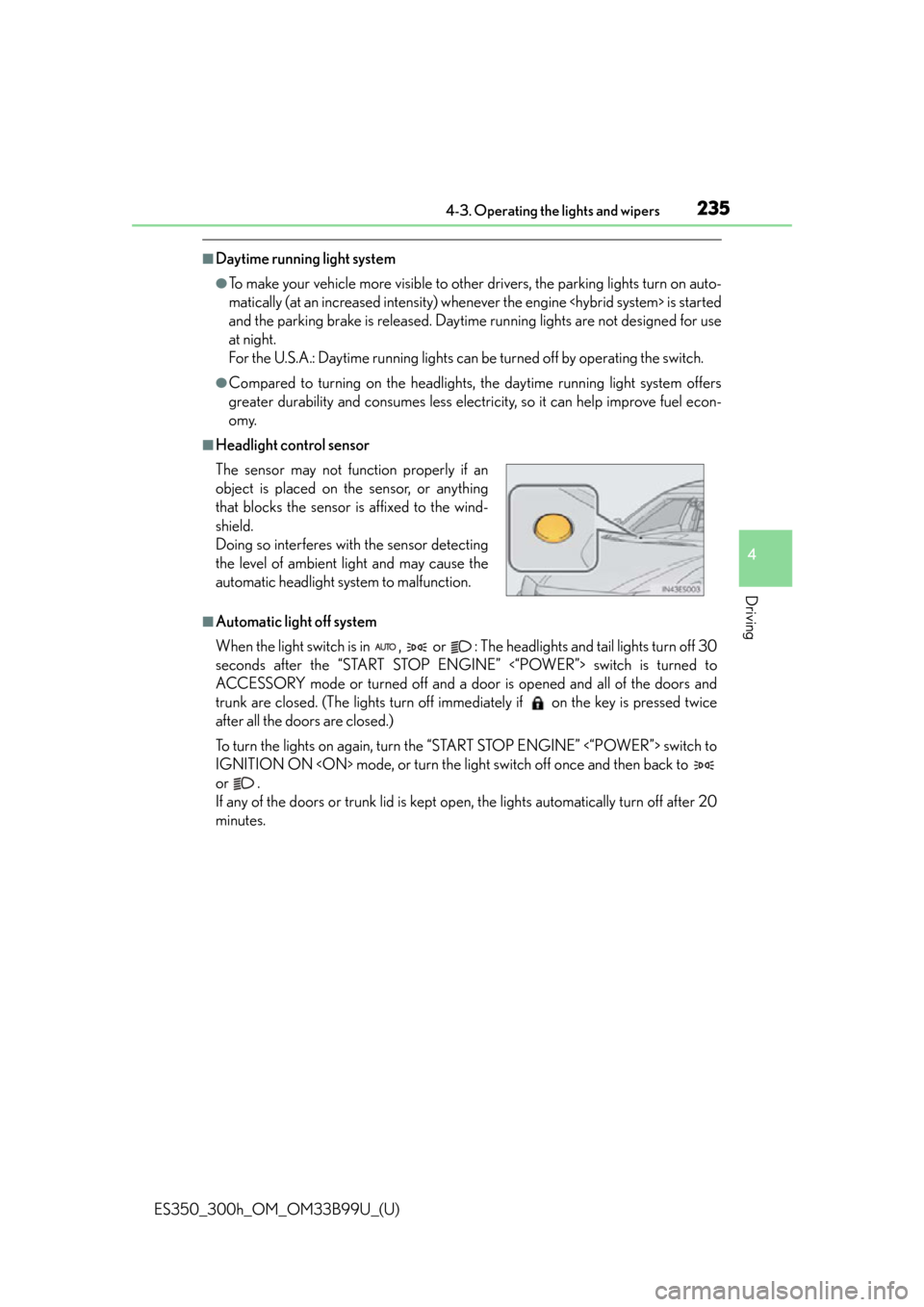brake light Lexus ES300h 2015 Do-it-yourself maintenance / Owner's Manual (OM33B99U)
[x] Cancel search | Manufacturer: LEXUS, Model Year: 2015, Model line: ES300h, Model: Lexus ES300h 2015Pages: 784, PDF Size: 9.63 MB
Page 3 of 784

3
ES350_300h_OM_OM33B99U_(U)
1
9 8
7
6 4 3
2
10
5
4-1. Before drivingDriving the vehicle ..................... 188
Cargo and luggage.................... 199
Vehicle load limits ...................... 202
Trailer towing ............................... 203
Dinghy towing ............................. 204
4-2. Driving procedures Engine (ignition) switch (gasoline vehicles) .................. 205
Power (ignition) switch (hybrid vehicles) ........................ 212
EV drive mode (hybrid vehicles) ........................219
Automatic transmission (gasoline vehicles) .................. 222
Hybrid transmission (hybrid vehicles) ...................... 226
Turn signal lever .......................... 230
Parking brake ................................231
Horn ................................................ 232
4-3. Operating the lights and wipers
Headlight switch ........................ 233
Automatic High Beam..............237
Fog light switch ............................244
Windshield wipers and washer .................................245
4-4. Refueling Opening the fuel tank cap ......249 4-5. Using the driving support
systems
Cruise control ............................. 254
Dynamic radar cruise control............................ 258
LDA (Lane Departure Alert).........273
Intuitive parking assist ................281
Lexus parking assist monitor........................................ 294
Driving mode select switch .............................................. 311
Driving assist systems ................313
Hill-start assist control (hybrid vehicles) ........................319
PCS (Pre-Collision System) ...........321
BSM (Blind Spot Monitor)..... 328 •Blind Spot Monitor function .................................... 332
• Rear Cross Traffic Alert function .................................... 335
4-6. Driving tips Hybrid vehicle driving tips (hybrid vehicles) ..................... 338
Winter driving tips .......................341
4Driving
Page 19 of 784

19Pictorial index
ES350_300h_OM_OM33B99U_(U)Multi-information display . . . . . . . . . . . . . . . . . . . . . . . . . . . . . . . . . . . . . . . . . . . P. 102
Display . . . . . . . . . . . . . . . . . . . . . . . . . . . . . . . . . . . . . . . . . . . . . . . . . . . . . . . . . . . .
. .P. 102
When the warning messages are displayed . . . . . . . . . . . . . . . . . . . . . . . . . P. 636
Parking brake . . . . . . . . . . . . . . . . . . . . . . . . . . . . . . . . . . . . . . . . . . . . . . . . . . . . . . . . P. 231
Applying/releasing . . . . . . . . . . . . . . . . . . . . . . . . . . . . . . . . . . . . . . . . . . . . . . . . . .P. 231
Precautions against winter season . . . . . . . . . . . . . . . . . . . . . . . . . . . . . . . . . . P. 342
Warning buzzer/message . . . . . . . . . . . . . . . . . . . . . . . . . . . . . . . . . . . . P. 626, 643
Turn signal lever. . . . . . . . . . . . . . . . . . . . . . . . . . . . . . . . . . . . . . . . . . . . . . . . . . . . . . P. 230
Headlight switch . . . . . . . . . . . . . . . . . . . . . . . . . . . . . . . . . . . . . . . . . . . . . . . . . . . . . P. 233
Headlights/parking lights/tail lights/dayti me running lights . . . . . . . . . . P. 233
Fog lights . . . . . . . . . . . . . . . . . . . . . . . . . . . . . . . . . . . . . . . . . . . . . . . . . . . . . . . . . . . P. 244
Windshield wiper and washer switch. . . . . . . . . . . . . . . . . . . . . . . . . . . . . . . . P. 245
Usage . . . . . . . . . . . . . . . . . . . . . . . . . . . . . . . . . . . . . . . . . . . . . . . . . . . . . . . . . . . . . . P. 245
Adding washer fluid . . . . . . . . . . . . . . . . . . . . . . . . . . . . . . . . . . . . . . . . . . . . . . . . . P. 561
Warning messages . . . . . . . . . . . . . . . . . . . . . . . . . . . . . . . . . . . . . . . . . . . . . . . . . P. 649
Emergency flasher switch . . . . . . . . . . . . . . . . . . . . . . . . . . . . . . . . . . . . . . . . . . . . P. 614
Fuel filler door opener . . . . . . . . . . . . . . . . . . . . . . . . . . . . . . . . . . . . . . . . . . . . . . . .P. 251
Refueling method. . . . . . . . . . . . . . . . . . . . . . . . . . . . . . . . . . . . . . . . . . . . . . . . . . . P. 249
Fuel type/fuel tank capacity . . . . . . . . . . . . . . . . . . . . . . . . . . . . . . . . . . . . . . . . . P. 704
Trunk opener. . . . . . . . . . . . . . . . . . . . . . . . . . . . . . . . . . . . . . . . . . . . . . . . . . . . . . . . . . P. 1 4 9
Hood lock release lever . . . . . . . . . . . . . . . . . . . . . . . . . . . . . . . . . . . . . . . . . . . . . .P. 541
Tilt and telescopic steering control switch
*1. . . . . . . . . . . . . . . . . . . . . . . . . P. 169
Tilt and telescopic steering lock release lever
*1 . . . . . . . . . . . . . . . . . . . . P. 169
Air conditioning system . . . . . . . . . . . . . . . . . . . . . . . . . . . . . . . . . . . . . . . . . . . . . P. 464
Usage . . . . . . . . . . . . . . . . . . . . . . . . . . . . . . . . . . . . . . . . . . . . . . . . . . . . . . . . . . . . . .P. 464
Rear window and outside rear view mirror defoggers . . . . . . . . . . . . . . . P. 470
Audio system
*2. . . . . . . . . . . . . . . . . . . . . . . . . . . . . . . . . . . . . . . . . . . . . . . . . . . . . . P. 350
Hands-free system . . . . . . . . . . . . . . . . . . . . . . . . . . . . . . . . . . . . . . . . . . . . . . . . . .P. 419
*1: If equipped
*2: For vehicles with a navigation system, refer to
“NAVIGATION SYSTEM OWNER’S MANUAL”.
4
5
6
7
8
9
10
11
12
13
14
15
Page 93 of 784

ES350_300h_OM_OM33B99U_(U)
932. Instrument cluster
2
Instrument cluster
◆Outside rear view mirrors (vehicles with BSM)
Warning lights inform the driver of ma lfunctions in the indicated vehicle’s
systems.
Warning lights
*1
(U.S.A.)
Brake system warning light
( P. 6 2 6 )*1Electric power steering
system warning light
( P. 6 2 8 )
*1
(Canada)
Brake system warning light
( P. 6 2 6 )*1
Slip indicator ( P. 6 2 8 )
*1
Charging system warning
light ( P. 6 2 7 )
*1
(hybrid
vehicles)
Brake system warning light
( P. 6 2 8 )
*1
(U.S.A.)
Malfunction indicator
lamp ( P. 6 2 7 )*1
(if equipped)
Automatic headlight level-
ing system warning light
( P. 6 2 8 )
*1
(Canada)
Malfunction indicator
lamp ( P. 6 2 7 )Open door warning light
( P. 6 2 9 )
*1SRS warning light
( P. 6 2 7 )Low fuel level warning light
( P. 6 2 9 )
Page 187 of 784

187
ES350_300h_OM_OM33B99U_(U)
4Driving
4-1. Before drivingDriving the vehicle ......................188
Cargo and luggage .................... 199
Vehicle load limits ......................202
Trailer towing ................................203
Dinghy towing..............................204
4-2. Driving procedures Engine (ignition) switch (gasoline vehicles) ................. 205
Power (ignition) switch (hybrid vehicles) ....................... 212
EV drive mode (hybrid vehicles) ....................... 219
Automatic transmission (gasoline vehicles) .................. 222
Hybrid transmission (hybrid vehicles) ...................... 226
Turn signal lever ......................... 230
Parking brake ................................ 231
Horn.................................................232
4-3. Operating the lights and wipers
Headlight switch .........................233
Automatic High Beam ............. 237
Fog light switch............................ 244
Windshield wipers and washer ................................. 245 4-4. Refueling
Opening the fuel tank cap ..... 249
4-5. Using the driving support systems
Cruise control ............................. 254
Dynamic radar cruise control ............................258
LDA (Lane Departure Alert) .........273
Intuitive parking assist ............... 281
Lexus parking assist monitor ........................................ 294
Driving mode select switch .............................................. 311
Driving assist systems................ 313
Hill-start assist control (hybrid vehicles) ....................... 319
PCS (Pre-Collision System)........... 321
BSM (Blind Spot Monitor) ..... 328 • Blind Spot Monitor function .................................... 332
• Rear Cross Traffic Alert function .................................... 335
4-6. Driving tips Hybrid vehicle driving tips (hybrid vehicles) .....................338
Winter driving tips ...................... 341
Page 190 of 784

190
ES350_300h_OM_OM33B99U_(U)
4-1. Before driving
■Breaking in your new Lexus
To extend the life of the vehicle, observing the following precautions is recom-
mended:
●For the first 186 miles (300 km):
Avoid sudden stops.
●For the first 621 miles (1000 km):
• Do not drive at extremely high speeds.
• Avoid sudden acceleration.
• Do not drive continuously in low gears.
• Do not drive at a constant speed for extended periods.
■Drum-in-disc type parking brake system
Your vehicle has a drum-in-disc type parking brake system. This type of brake system
needs bedding-down of the brake shoes peri odically or whenever the parking brake
shoes and/or drum are replaced. Have your Lexus dealer perform the bedding
down operation.
■Operating your vehicle in a foreign country
Comply with the relevant vehicle registration laws and confirm the availability of the
correct fuel. ( P. 7 1 5 )
■For efficient use (hybrid vehicles)
●Shift the shift lever to D when driving.
In the N position, the gasoline engine oper ates but electricity cannot be generated.
The hybrid battery (traction battery) will discharge, requiring unnecessary engine
power to recharge.
●Drive your vehicle smoothly.
Avoid abrupt acceleration and decelerati on. Gradual acceleration and decelera-
tion will make more effective use of the electric motor (traction motor) without hav-
ing to use gasoline engine power.
●Avoid repeated acceleration.
Repeated acceleration consumes hybrid ba ttery (traction battery) power, resulting
in poor acceleration. Battery power can be restored by driving with the accelerator
pedal slightly released.
●Shift the shift lever to P when parking.
In the N position, the hybrid battery (traction battery) does not recharge.
Leaving the shift lever in the N position for an extended period of time may dis-
charge the hybrid battery. The vehicle cannot run if the hybrid battery is dis-
charged.
Page 191 of 784

ES350_300h_OM_OM33B99U_(U)
1914-1. Before driving
4
Driving
■Eco-friendly driving
Gasoline vehicles: P. 1 0 9
Hybrid vehicles: P. 1 0 0
■Customization (gasoline vehicles)
Setting of Eco Driving Indi cator Light can be changed.
(Customizable features: P. 7 3 0 )
CAUTION
Observe the following precautions.
Failure to do so may result in death or serious injury.
■When starting the vehicle
Always keep your foot on the brake pedal while stopped with the engine running
■When driving the vehicle
●Do not drive if you are unfamiliar with the location of the brake and accelerator
pedals to avoid depressing the wrong pedal.
• Accidentally depressing the accelerator pedal instead of the brake pedal will
result in sudden acceleration that may lead to an accident.
• When backing up, you may twist your body around, leading to a difficulty in operating the pedals. Make sure to operate the pedals properly.
• Make sure to keep a correct driving posture even when moving the vehicle only slightly. This allows you to depres s the brake and accelerator pedals prop-
erly.
• Depress the brake pedal using your right foot. Depressing the brake pedal using your left foot may delay response in an emergency, resulting in an acci-
dent.
●Hybrid vehicles only: When the hybrid vehicles are driven using the electric
motor only, no engine noise is made. As such, pedestrians, people riding bicycles
or other people and vehicles in the su rrounding area may not realize that the
vehicle is approaching. Even with the vehicle proximity notification system active,
people may not realize the vehicle is approaching when the surrounding area is
noisy and so forth. Therefore, take extra care while driving.
●Do not drive the vehicle over or stop the vehicle near flammable materials.
The exhaust system and exhaust gases can be extremely hot. These hot parts may
cause a fire if there is any flammable material nearby.
Page 192 of 784

192
ES350_300h_OM_OM33B99U_(U)
4-1. Before driving
CAUTION
Observe the following precautions.
Failure to do so may result in death or serious injury.
■When driving the vehicle
●During normal driving, do not turn off the engine
engine
control, but the power assist to these syst ems will be lost. This will make it more
difficult to steer and brake, so you should pull over and stop the vehicle as soon as
it is safe to do so.
However, in the event of an emergency, such as if it becomes impossible to stop
the vehicle in the normal way: P. 6 1 5
●Use engine braking (downshift) to maintain a safe speed when driving down a
steep hill.
Using the brakes continuously may cause the brakes to overheat and lose effec-
tiveness. ( P. 223, 227)
●Do not adjust the positions of the steering wheel, the seat, or the inside or outside
rear view mirrors while driving.
Doing so may result in a loss of vehicle control.
●Always check that all passengers’ arms, heads or other parts of their body are not
outside the vehicle.
●Do not drive in excess of the speed limit. Even if the legal speed limit permits it, do
not drive over 85 mph (140 km/h) unless your vehicle has high-speed capability
tires. Driving over 85 mph (140 km/h) may result in tire failure, loss of control and
possible injury. Be sure to consult a tire dealer to determine whether the tires on
your vehicle are high-speed capability tires or not before driving at such speeds.
■When driving on slippery road surfaces
●Sudden braking, acceleration and steeri ng may cause tire slippage and reduce
your ability to control the vehicle.
●Sudden acceleration, engine braking due to shifting, or changes in engine speed
could cause the vehicle to skid, resulting in an accident.
●After driving through a puddle, lightly depress the brake pedal to make sure that
the brakes are functioning properly. Wet brake pads may prevent the brakes from
functioning properly. If the brakes on only one side are wet and not functioning
properly, steering control may be affected.
Page 195 of 784

ES350_300h_OM_OM33B99U_(U)
1954-1. Before driving
4
Driving
CAUTION
■When the vehicle is parked
●Do not leave glasses, cigarette lighters, spray cans, or soft drink cans in the vehi-
cle when it is in the sun.
Doing so may result in the following:
• Gas may leak from a cigarette lighter or spray can, and may lead to a fire.
• The temperature inside the vehicle may cause the plastic lenses and plastic material of glasses to deform or crack.
• Soft drink cans may fracture, causing the contents to spray over the interior of the vehicle, and may also cause a short circuit in the vehicle’s electrical com-
ponents.
●Do not leave cigarette lighters in the vehicle. If a cigarette lighter is in a place such
as the glove box or on the floor, it may be lit accidentally when luggage is loaded
or the seat is adjusted, causing a fire.
●Do not attach adhesive discs to the windshield or windows. Do not place contain-
ers such as air fresheners on the instru ment panel or dashboard. Adhesive discs
or containers may act as lenses, causing a fire in the vehicle.
●Do not leave a door or window open if the curved glass is coated with a metal-
lized film such as a silver-colored one. Reflected sunlight may cause the glass to
act as a lens, causing a fire.
●Always apply the parking brake, shift the shift lever to P, stop the engine
Do not leave the vehicle unattended while the engine is running
●Do not touch the exhaust pi pes while the engine is running
Doing so may cause burns.
Page 235 of 784

ES350_300h_OM_OM33B99U_(U)
2354-3. Operating the lights and wipers
4
Driving
■Daytime running light system
●To make your vehicle more visible to other drivers, the parking lights turn on auto-
matically (at an increased intensity) whenever the engine
and the parking brake is released. Daytime running lights are not designed for use
at night.
For the U.S.A.: Daytime running lights can be turned off by operating the switch.
●Compared to turning on the headlights, the daytime running light system offers
greater durability and consumes less electricity, so it can help improve fuel econ-
omy.
■Headlight control sensor
■Automatic light off system
When the light switch is in , or : The headlights and tail lights turn off 30
seconds after the “START STOP ENGINE” <“POWER”> switch is turned to
ACCESSORY mode or turned off and a door is opened and all of the doors and
trunk are closed. (The lights turn off imme diately if on the key is pressed twice
after all the doors are closed.)
To turn the lights on again, turn the “START STOP ENGINE” <“POWER”> switch to
IGNITION ON
or .
If any of the doors or trunk lid is kept op en, the lights automatically turn off after 20
minutes. The sensor may not func tion properly if an
object is placed on the sensor, or anything
that blocks the sensor is affixed to the wind-
shield.
Doing so interferes with the sensor detecting
the level of ambient light and may cause the
automatic headlight system to malfunction.
Page 291 of 784

ES350_300h_OM_OM33B99U_(U)
2914-5. Using the driving support systems
4
Driving
■Intuitive parking assist display
When an obstacle is detected while the rear view monitor system is in use, the warn-
ing indicator will appear in the top right of the screen even if the display setting has
been set to off.
■Sensor detection information
●The sensor’s detection areas are limited to the areas around the vehicle’s front cor-
ners and rear bumper.
●Certain vehicle conditions and the surrou nding environment may affect the ability
of the sensor to correctly detect obstacles. Particular instances where this may
occur are listed below.
• There is dirt, snow or ice on the sensor. (Wiping the sensors will resolve this problem.)
• The sensor is frozen. (Thawing the area will resolve this problem.) In especially cold weather, if a sensor is frozen the screen may show an abnor-
mal display, or obstacle s may not be detected.
• The sensor is covered in any way.
• The vehicle is leaning considerably to one side.
• On an extremely bumpy road, on an incline, on gravel, or on grass.
• The vicinity of the vehicle is noisy due to vehicle horns, motorcycle engines, air brakes of large vehicles, or other loud noises producing ultrasonic waves.
• There is another vehicle equipped with parking assist sensors in the vicinity.
• The sensor is coated with a sheet of spray or heavy rain.
• The vehicle is equipped with a fender pole or wireless antenna.
• Towing eyelets are installed.
• The bumper or sensor receives a strong impact.
• The vehicle is approaching a tall or curved curb.
• In harsh sunlight or intense cold weather.
• The area directly under th e bumpers is not detected.
• If obstacles draw too close to the sensor.
• A non-genuine Lexus suspension (low ered suspension etc.) is installed.
• People may not be detected if they are wearing certain types of clothing.
In addition to the examples above, there are instances in which, because of their
shape, signs and other objects may be judged by the se nsor to be closer than they
are.